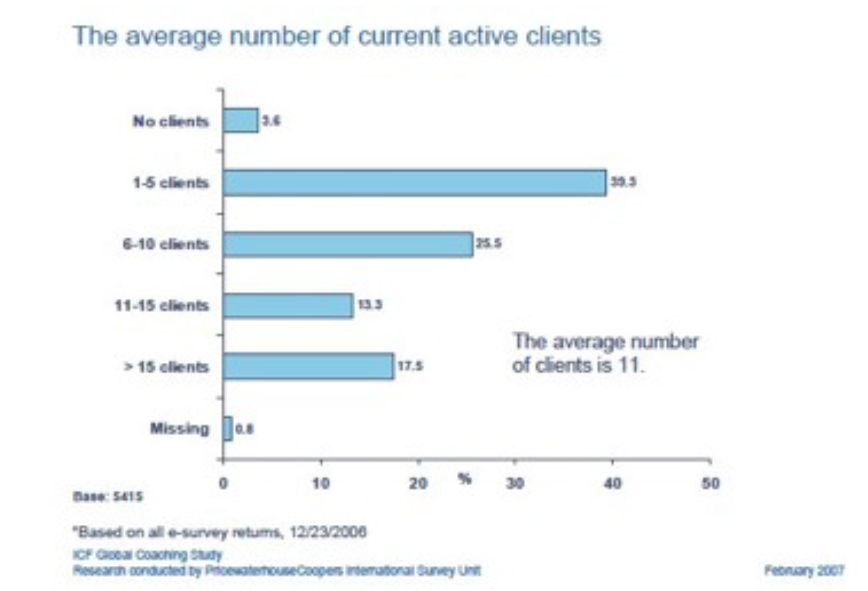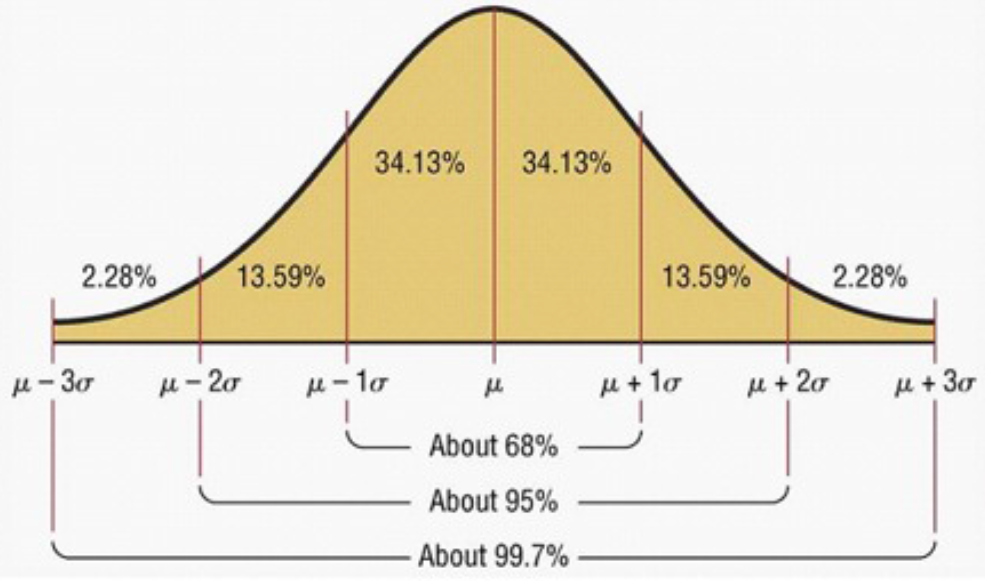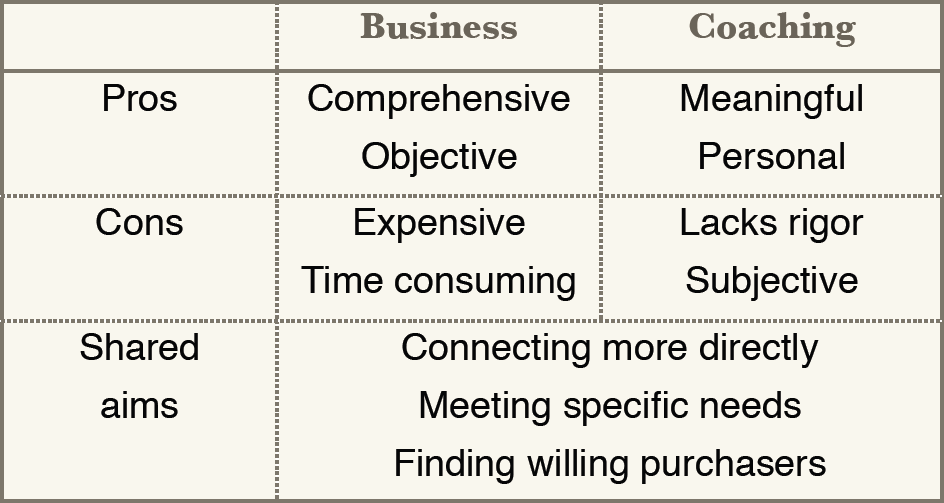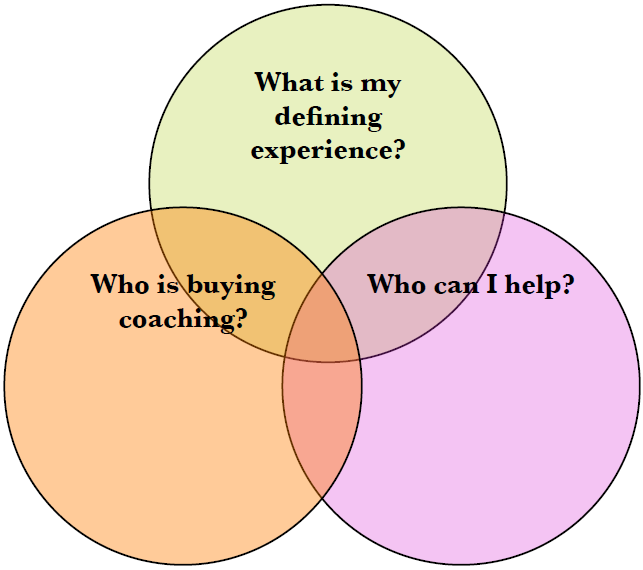Research Paper By Dawn Waldron, Professional Coach, United Kingdom

This paper presents a coaching-centered model for finding a business niche to help coaches and complementary therapists identify the market segment that they are best suited to serve. The author discusses classic niche marketing techniques and adapts the theory to provide a new model for identifying clients that take into account the values and life experience of the coach as well as commercial considerations to target a group that is willing and able to buy the service presented.
The biggest challenge facing the qualified coach is finding a supply of regular clients. With the majority of coaches having less than 10 active clients, and most of these reporting 5 or less (ICF, 2008) the ability to earn a living from coaching is debatable. It is widely accepted that coaches are more successful when they establish a niche for themselves but the evidence shows that few coaches exploit the potential of this idea.
Over half of qualified coaches have obtained an advanced degree, and two-thirds place great emphasis on professional development but relatively few come from an established marketing background (ICF, 2008). Such emphasis is placed on authenticity and integrity that commercial sales and marketing models have little appeal. A model is needed that sits happily within the caring culture of coaching.
This paper presents a new marketing model which combines business analysis with a coaching approach to help small businesses identify a market niche that makes economic and emotional sense, allowing them to measure success by evaluating profit and purpose at the same time, without sacrificing one for the other. It is a useful model for coaches and their business clients.

Niche Marketing Theory
Niche marketing is the process of identifying a defined segment of people who are likely and able to buy a specific product and tailoring a proposition to suit them.
The theory derives from the market segmentation model, an economic and marketing theory, which divides purchasers into groups with similar needs, for example, gender, occupation, health. By grouping consumers in this way it is possible to target them efficiently and address them directly (Lake, 2009).
In the early 1900s manufacturers were selling to undifferentiated markets. The new industrial age meant that most customers were satisfied with standardized goods, typified by the Model T Ford (Harvard, 2005). As competitors entered the market the need for differentiation increased.
In the early 2000s, the surge of internet marketing made it easier to design and promote very specific product offerings to clearly defined groups. This kind of marketing is ideal for small service businesses with modest marketing budgets.
Fig 2: Standard distribution curve (Bowman, 2009)

Small businesses do not need a large segment to be profitable; they can operate at either end of the standard distribution curve where there is less competition for customers and more scope for offering superior service and choice (Anderson, 2007).
A Business Approach
Large companies use quantitative multifactor analysis to identify market segments to identify profitable new groups of consumers and reduce the risk of new marketing ventures. They assess the whole market seeking untapped opportunities, studying buyer behavior including frequency and total spend, as well as the factors that prompt buying decisions: a costly process. They may carry out supplementary research into the more profitable-looking segments to identify market growth potential, competition, and accessibility of consumers (Harvard, 2005). The body of data is analyzed for segments, which offer the closest fit for their product; occasionally the research leads to a completely new product for a new segment. They will relate it to the company’s existing customer base, identify pockets of new opportunity, possibly new marketing partners, and select a profitable niche (Neilsen, 2011).
Large-scale market segmentation usually takes place when a company has achieved substantial market share in one segment of a market and is looking for further areas to diversify into. They have the budget and capability to carry out the work to a high level of rigor.
Smaller businesses, with fewer resources, aiming for a stake in a market, can adapt the classic model to suit their capability and budget. A good starting point would be to decide either to sell a specific product or serve a key market. For example, a clothing manufacturer may start with their product, aiming to attract a group of young executives or whereas a service provider may identify an affluent market segment of 50-year old women and design an offering to appeal to them. There is still a need to ensure your product is attractively priced and promoted but taking a cool, objective look at your market to see what is missing makes good business sense before you leap in with a new product.
Many coaches, however, will not be satisfied simply with choosing an efficient, profitable niche. Nearly 65% of coaches are dedicated towards personal development (ICF, 2008) for themselves and their clients; there is likely to be a pull towards more personal and meaningful ways of selecting a niche.
So how can coaches keep the benefits of the business model and make it feel more meaningful?
Conversations with several ICA students indicate they are planning to select their niche in line with the Communities of Practice workshops offered by the college. These valid niches already support a growing number of coaches. New entrants will be faced with the challenge of how to stand out.
Chatting with coaches in a local networking group revealed that few had given much thought to niche marketing beyond pondering how to describe themselves: Life Coach, Wellness Coach, Relationship Coach, etc. Most were offering a broad-based service in the belief that it is better to be available to everyone. None had looked at the market, identified segments, and deliberately targeted them.
Why not?
A strong belief for coaches is the unique individuality of themselves and their clients. Coaches recognize that no two people are alike. The idea seems to undermine the concept of niche marketing. If everyone is unique, how can one, target groups?
One answer to that question is that, although humanity is diverse, we have connecting themes: dreams, passions, and ideas, defining experiences. Highlighting these deeply personal qualities is the way to add more meaning to your marketing message and to create a more profound connection with your client.
Among the coaches asked most had entered the profession as a second career; most had a deep-seated desire to make a difference; most could point to a turning point that influenced their decision to become a coach.
The evidence suggested that the ‘turning point’ is a critical factor for coaches in finding the market segment they are best designed to serve, and so it was decided to test that theory by asking coaches on Twitter how they found their niche. It is reasonable to assume that people on Twitter are making a decisive attempt to reach their market and are more likely to be targeting a niche:
The Question:
The Answers:



The Turning Point
For coaches, it seems that there is a turning point that is key to connecting with clients. The Twitter conversation led to the following descriptions of turning points:
It was when I was diagnosed with cancer. I left the consultant’s office and no one was waiting for me to offer me any help or advice. I decided to devote my life to making sure no one else ever had to feel so hopeless. (Waldron, 2011)
I was sitting in the barber’s chair and I saw this grey faced man staring back at me. I didn’t recognize him. I knew it was time to change my life. And that there were thousands of other people like me wanting to do the same thing. (Crofts, 2011)
I’ve got stories to tell and people to motivate. And…I’ve got a revolution to start. A revolution founded on people pursuing their dreams and living out loud and taking their own big leaps, a revolution that I believe can change the world. (Maurer, 2011)
I spent my whole life trying to climb the corporate ladder. Then one day I sat back and realized that what I’m really good at is spotting what other people are really good at. It was a stark realization. My success came from helping others to succeed. So that’s what I do now. (Foster, 2011)
In each of these cases, a profound personal experience has led to a sense of universal connection with others in the same situation. The niche they are drawn to has become sharply defined through a moment of intense personal insight.
A Combined Approach
Can these two different approaches be combined to find a market segment that makes sense from both a commercial and a ‘personal meaning’ perspective?
Both the approaches described are a form of niche market identification: the first, a logical, quantitative approach that aims to reduce risk and priorities profit; the second an emotional, experiential approach that taps into purpose and passion. Both appear to be valid though they may seem contradictory.
A model that combined the best of both approaches would be valuable.
The positive aspects of each approach are highlighted in the table below (Figure 3), showing that the ideal model would look at the whole market objectively, while still recognizing the relevance of personal experience and meaning. It would aim to do this within a realistic budget and timescale, while still being reliable.
When the two methods are compared side-by-side, it becomes easier to see that they are not mutually exclusive. There are some important areas of crossover including:
- Communicating with customers in a shared, specific language
- Finding customers who really need/want what you are offering
- Targeting customers with the ability to buy

Three Critical Questions
By looking at the overlapping aims of each approach it is possible to formulate the questions that the new coach needs to ask and answer.
- What is my defining experience? (Articulating shared language/experience)
- Who are the people I want to help? (Identifying who really needs help)
- Who is buying coaching services? (Targeting customers with the ability to buy)
The point at which these three questions overlap is the niche market that our coaching business is best designed to serve.

Although the scope of the surveys was limited, it is clear that the coaches asked to have a deep understanding of what makes them uniquely qualified to help others. An hour spent looking at coaching websites shows that most fail to take the important step of targeting their message to their niche, although it is the most critical.
When setting up in business it feels counter-intuitive to exclude 90% of potential customers to focus on just 10%: there is innate resistance to turning people away. Yet, English-speaking coaches are normally prepared to accept that they won’t be coaching Japanese-speaking clients.
Targeting your niche is just another way of making sure you are speaking the client’s language (Harvard, 2005). By excluding the segments you don’t want to talk to, you can talk more directly to your customers. They are more likely to relate to your message, to feel understood by you, and then engage your services.
This paper has shown how identifying a niche market can provide more direct access to clients. The classic business model of market segmentation has been examined and compared with a more unusual coaching approach. There is value in both.
By looking at where the two models interconnect it is possible to design a set of questions that can be asked and answered to identify a profitable and purposeful niche market ideally suited to both the coach and the clients who need it.
The process can be repeated for multiple niches within single coaching practice.
References
Anderson, Chris (2007) The Long Tail: How Endless Choice is Creating Unlimited Demand. Random House.
Bowman (2009) Statistics Notes – Properties of Normal Distribution 2. [Online] Available from: http://rchsbowman.wordpress.com/2009/11/page/2/. Accessed 3.6.11
Crofts, N (2011) Interview with Dawn Waldron. 12.4.11
Foster, S (2011) Interview with Dawn Waldron. 24.5.11
Harvard Business School (2005) Market Segmentation, Targeting, and Positioning. Harvard Business School Press.
ICF (2008) Global Coaching Study, Executive Summary. ICF Website. Accessed 3.6.11
Lake, Laura (2009) Consumer Behaviour for Dummies. Wiley.
Maurer, A (2011) Interview with Dawn Waldron. 26.5.11
McNamara, Hannah (2007) Niche Marketing for Coaches. Thorogood.
Nielsen Consulting (2011) Website: Market Structure and Segmentation. [Online] Available from: http://www.nielsen.com/uk/en/practices/market-structure-segmentation.html. Accessed 3.6.11
Waldron, D (2011) Personal experience, recorded 4.6.11
Profile
Dawn Waldron is a Professional Coach, Nutritionist, Author, and Public Speaker. Her coaching practice, Vocation Location, is designed to help people do something they love with their lives. Finding your life purpose and your niche is part of that process.
Email: dawnwaldron@mac.com
Web site: http://www.dawnwaldron.com

